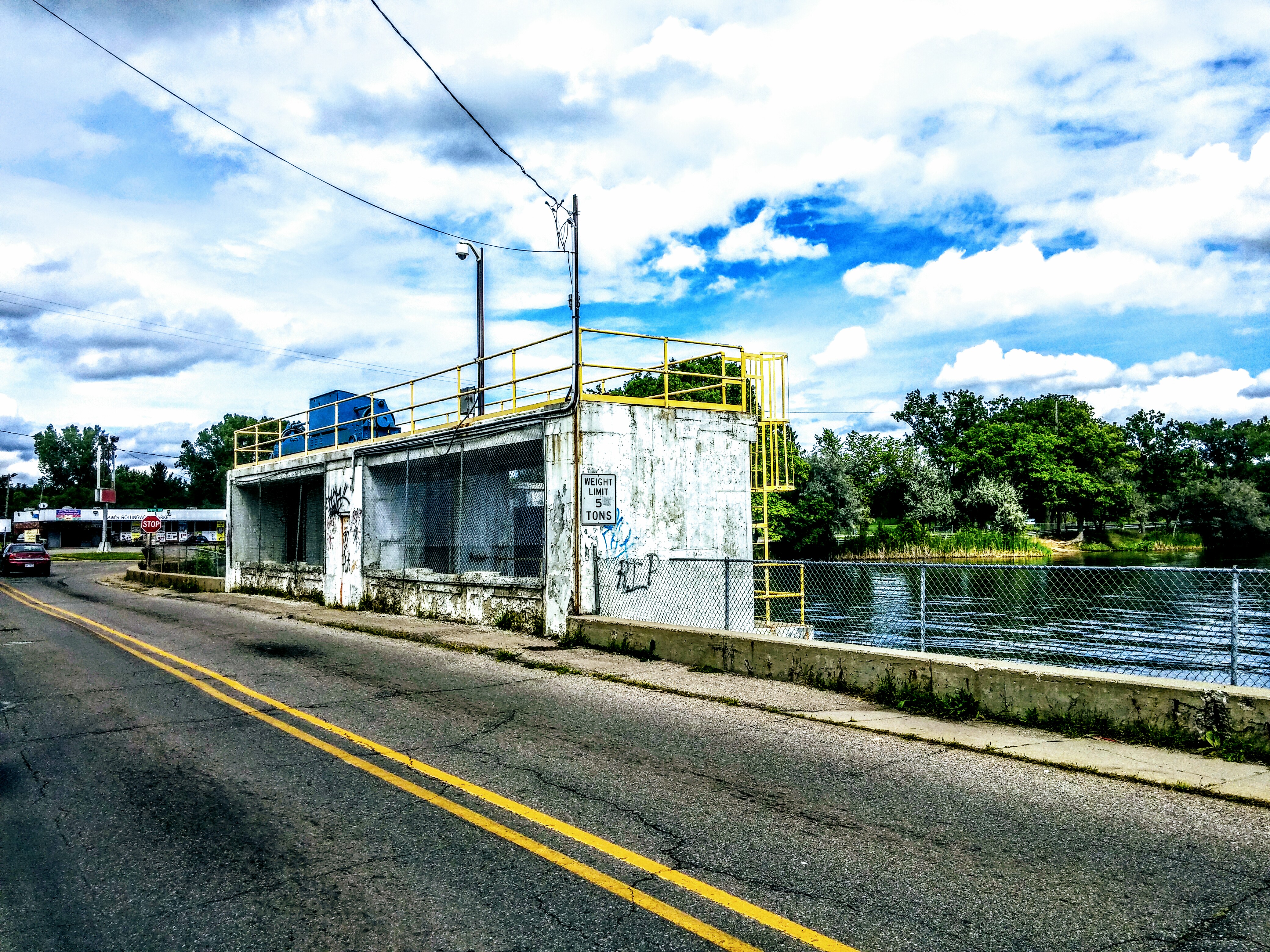By Jeffery L Carey Jr.
As the year winds down, the City of Flint has begun its fourth dam project, this one at the Kearsley Dam at the corner of Layton Boulevard and Western Road.
Work on the Kearsley Dam follows the recent repair of Thread Lake Dam and the removal of both the Fabri and Hamilton Dams. The announcement of work beginning on the Kearsley Dam came Aug.31 from Mayor Karen Weaver and the city’s Director of Public Works Rob Bincsik.
The much-needed work on the dam comes after an incident in April when a gate got stuck open. The gate failure caused a large percentage of Kearsley Lake to drain.
“Each gate is capable of a 200-year storm, but the one gate has not worked,” said Mark Adas, an engineer for the City of Flint. “We have not used the one gate for years,” he said “and the other gate was sticking up ‘cockeyed’ so they had to vibrate it down with a back hoe.”
Kearsley Dam rehab work includes gate replacement

Kearsley Dam in obvious need of rehab, viewed from Western Road toward the reservoir created by the dam (Photo by Jeffery L. Carey, Jr.)
The rehabilitation work on Kearsley Dam will be handled by Fisher Contracting, barring any union issues with the crane operator, Adas explained. A diving inspector already has started underwater assessments of the dam, to repair the sluice gates and look for other necessary repairs. Currently, there is no expected date of completion as underwater assessments still need evaluation.
According to Adas, each gate will be replaced one at a time including the two large gates and the sluice gates. “The sluice gates are easier to operate,” Adas said. “Once these are replaced we should be able to regulate the water better.”
He also stated there’s potential to work with the Michigan Department of Transportation (MDOT) next year to widen Western Road at the dam where it crosses over the creek. As for the blight and burned out trailer park adjacent to the dam, there are currently no plans with the property which is held by the Genesee Land Bank, he said.
As for concerns over potential contamination being released downstream due to the work stirring up the sediment, Paul Bucholtz from the Michigan Department of Environmental Quality (MDEQ) stated, “Repair of the gates and gate guides (based on discussions between MDEQ and the city of Flint), would not have a significant impact on sediment in the impoundment, so the MDEQ does not anticipate many concerns. However, we have not received any plans or a permit application, so we don’t have all the details for what the final project will entail.”
Kearsley Dam project funding to rely on city
No money was granted from the state for the work on Kearsley Dam, leaving the expense of the project to come from the city’s budget. According to the City of Flint Five Year Financial Plan 2018-2022, the current recommended budget for Water Plant and Dam Maintenance is $625,000, with budgets projected over the next four years at $625,000, $631,250, $637,563, and $643,938.
Due to the breach at Thread Lake this summer though some of that budget was reallocated to repair the dam, leaving the rest of the budget for repair on the Kearsley Dam and the required work on Flint’s Water Treatment Facility. “There are a lot of issues,” Adas said. “Technically the river is still our secondary water supply.”

Flint River with much altered remains of the Hamilton Dam (Photo by Darlene Carey)
According to MDEQ requirements, the city must keep the river as a backup water source. This means the reservoir created by the concrete base of Hamilton Dam must stay in place.
Also, the City of Flint must maintain the pipeline from the water plant to the county in order to create a backup water supply. “We would never go to it though,” Adas stated. “That would be political suicide.”
Original “rapids” project plan floundering
Other issues involving what is left of the Hamilton Dam and the planned “water-based recreational opportunities” described by Genesee County Parks and Recreation have arisen as well. The plans were to include whitewater rapids built into the Flint River with greater public access for canoeing and kayaking. Some of that is happening: an “ecotourism popup” kayaking opportunity has just been announced by the Flint River Watershed Coalition with river access west of the dam.
Also described by the Flint River Restoration Project is the intent to improve ecology with access for fish, crayfish, snails and other organisms to move freely upstream, in an attempt to improve conditions of the Flint River for fishing.
According to Adam Moore, associate planner for the City of Flint, “The first set of in-stream designs (a.k.a. the rapids) have gone to the State of Michigan, Department of Environmental Quality, and Department of Natural Resources for review and a public hearing on the permit for that work will be scheduled soon.”
The “rapids” project is currently floundering though as city officials work with the MDEQ, Fish and Wildlife, FEMA, and the Army Corps of Engineers to determine if the plan is even feasible.
River modifications await permit decision, review
According to Bucholtz, the MDEQ is currently reviewing a permit application that proposes further modifications to the Hamilton Dam and the installation of rock fill for in-stream recreation structures. The original application “did not contain all of the information we would need to make a permit decision,” Bucholtz said, “so we are awaiting additional information in order to proceed with processing.”
“As for timing,” Bucholtz said, “ it’s up in the air until we receive and review all the information we need to make a decision; engage other federal, state, and local stakeholders; process all their comments/concerns; and make a final permit decision on whether or not the proposed project can be completed in accordance with state and federal regulations. As such, it is difficult to say when the project could get underway.”
Much of the decision will be based on reestablishing the flood plain, Adas said, adding, “We don’t want to put in a bunch of rocks and cause flooding.” Because of this the city is working with the various agencies to do modeling and surveys to map out a new flood plain with the potential removal of some of the levy walls, widening the river and opening up a natural area for flooding.
Regarding Thread Lake, work on that dam is complete and the lake is filing back up. “There are portions that look different now because of the type of vegetation that came up while the lake bottom was exposed,” stated Rebecca Fedewa, executive director for the Flint River Watershed Coalition. “I can’t say for sure, but I imagine after the winter freeze, those parts of the lake will begin to look more like they previously had.”
Thread Lake residents still have concerns
With the lake returning to its approximate four-foot depth, Mona Munroe-Younis, a resident of the Thread Lake community added, “I appreciate that the City of Flint made the necessary repairs to create a permanent fix in order to maintain the asset of the Thread Lake in Flint and my neighborhood.”
She did state, however, that without additional investment in maintaining the lake, it will take more time, perhaps a year or more, before the lake has the same aesthetic appeal as it did prior to the dam break.
This concern comes because, especially on the most shallow south side of the lake, mats of tall grasses overtook the lakebed and now appear to prevent the water from reaching the former edge of the lake. With the lake being very shallow and not having been dredged in decades to deepen the lake channel, much of the lake clogs with lily pads each summer, which also affects the south side. “The lily pads at least were more attractive than the tall grasses,” said Munroe-Younis, “but we’ll see if a cold winter changes the composition of the vegetation in Thread Lake next spring!”
“I’m relieved, though,” Munroe-Younis said. “I really hope the south side of the lake is naturally restored. Dredging the lake to make it deeper is rightfully low on the list of the city’s priorities and probably not on the list at all.”
EVM staff writer Jeffery L. Carey Jr. can be reached at jlcareyjr@hotmail.com.


You must be logged in to post a comment.